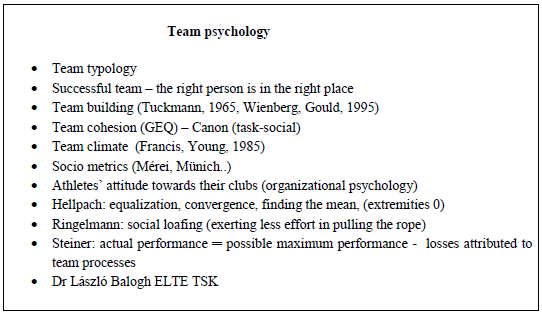Introduction to sports social-psychology
Being the member of a team sports or doing sports activities individually athletes always belong to a community. Sports clubs or their sections secure the frame around the work needed for high achievement. Besides the support of coaches and sports partners performance also depends on the relationship with managements and staff members of a club. In each sports group and team the phenomena of social-psychology and organizational-psychology play an important role to build up relationship with partners and team members. In his book Mérei (1996) describes those phenomena of social-psychology which primarily have impact on our life. The processes affecting our and others’ behaviour very often cannot be detected. Sports is no exception either.
In the followings we can learn about several sports theories.

Figure 14. Few crucial elements of team-psychology
First, the meaning of sports-psychology should be defined.7
The question rises here, what is meant by a sports team? Team can be defined as a kind of organization. According to the public awareness the notion of team means either football or handball teams. But professionals often list here, for example, rowing, tennis doubles or gymnastics team championships. The other question is what the main differences among these factors are. Professionals define each sports and its section a team if athletes contest with minimum another of his/her team mate. Studies within this area of sports analyse these sports from different angles. In the followings a few points of view are highlighted.
Team cohesion can be interactive, depending on how much effort the team members invest into their work (hand- basket- volley- basket- football etc). In these sports results primarily depend on the quality of interaction, interplay, and the competences of cooperation. Now it can be understood that because of interactions a given structure will develop within which each of the participant must find his/her place, even in the “changing rooms”. There are sports where the results are added up within teams and this is called additive or summative team types (kayak-canoe, tennis doubles and gymnastics team championships etc.).
(Baumann, 2006).
In other theorists’ opinions there are interactive and coactive (there is no or little interaction within a team) types of sports. The features of interactive sports are that the individual activities should be harmonised with the other team members. Athletes can be high achievers if both the attacks and defence are adjusted to the motions of the other members. In this case the proverb saying “one swallow does not make summer” is true. Thus, relatively weaker teams can achieve success if the team members can cooperate (Baumann, 2006).
Cratty examining the relationship between cohesion and team-performance divided team sports into three groups (cited in Nagykáldi, 1998. p 97) while he analyzed the degree of cohesion generated by the tasks.
- Few interactions among teams and low coordination among their members (e.g.: archery, bowling, shooting, wrestling);
- High numbers of interactions and effective cooperation among players (hand-foot-valley-ball);
- Teams within both elements are present (jumping, rowing, exchange swimming).
The presence of cohesion supports athletes to harmonize their work. There are two things when cohesion works, that is, objectives to be achieved together and performance. These two factors are called cohesive force. Cohesion can come about if team members enjoy being together. To become high achievers both of these elements are needed as in case of problems there in no cooperation which would help athletes swing over hardships. When only team cohesion is present then after some time teams can forget about their tasks and goals.
The two basic components of cohesion appear differently in the above mentioned cases. The power of cohesive force of the task is higher within teams where the members can cooperate whereas the social cohesive force is lower. The teams being equipped with the abilities of cooperation the level of task and social cohesive force are almost the same.
Baumann (2006) dealing with the psychology of team sports refers to Steinerre (1972). It was him who examined the teams’ actual sports performance indicated by psychological factors. He proved that the teams’ performance is always lower than that of the individuals. The reason for this is lack of trust and the deficits deriving from dissatisfaction and loosing trust. He emphasises the need of further research.
Rókusfalvi (1992, p. 148) states that “ creating good atmosphere of sports associations and organizations healthy team spirit and excellent relationship between athlete and his/her coach are primarily belong to the tasks of sport professionals. All these factors always have objective consequences (goals) reflecting performance”. Both the inner and outer psychological load, strain and incidence of athletes determine their psychic load bearing capacity (Rókusfalvi, 1992). These elements are indispensable in the athletes’ attitudes towards their body and the relationship with their other team members.
The sports teams are specific organizations whose goals are the same and work along coordinated inner dynamics, structures and hierarchies. They are characterised with powerful identity which distinguish them from other sectors and organizations and strengthens their oneness. There are expectations whose fulfilment will increase the achievement. Its lack will decrease the possibility of achieving goals and aims. These mutual expectations are in the so called psychological contract. Therefore we can arrive at the following conclusion. The efficiency of sports associations and organizations has two elements. One of them is high achievement such as titles and winning cups etc. The other one is the efficiency of sports economy, for example, gaining high profit. Sometimes it may happen that a club works effectively considering its sport results but it does not function economically well. (A good example is the female Mizó-Pécs basketball team case. They won most of their matches but finally they got bankrupt as they were unable to manage their financial problems.) At the same time it happens that in most of the North American professional championships none of the teams are successful, they cannot be qualified for the playoffs, but due to the high number of matches, 80, within a season, the ticket sales, media and merchandising financially they are very efficient.

Figure 15. Subdivision of sports teams
Ringelmann, a French researcher who developed a theory in connection with an experiment where participants were asked to pull a rope so he could measure the force they extended. This is the so called “rope pulling” theory. With this he detected the phenomena of social loafing. He found that when more and more people were asked to participate in the activity the maximum effort of individuals became less and less. He discovered there was a productivity loss among individuals when combining their effort into a common pool. In other words individuals perceived no value to contributing and achieving the desirable outcome as they thought that the more they were the easier the task was, and it could be solved together and not individually. Athletes should become aware of this phenomenon especially when being shorthanded.
It has been observed that when two teams with different capacities had matches the weaker changed for the better whereas the members of the good team under-performed. Helpach’s construal level theory describes that there is a necessary convergence in the above mentioned case. Therefore it is important to prepare the athletes with competences enabling them not to underrate their opponents. They should not be surprised if the weaker team will start playing and performing much better.
Many sport leaders think if they buy a lot of players with excellent competences they will become a world class team. The characteristic feature of a team with high achievers is that everyone has found his/her place. There are not only “ballet players” but also “water carriers”. When team dynamic comes about it always means different quality. If “chemistry” works well a less able team may defeat the opponent players with excellent competences.
It takes time to have a well functioning team. According to Tuckman’s (see Nagykáldi, 1989) teamwork theory teams grow through 4 clearly defined stages, from their creation of groups of individuals, to cohesive task-forced teams. He suggests the following stages:
- Forming: the initial stage of team development during which everyone does his/her best to impress the others.
- Storming: at this stage players may challenge each other and starts fighting for better position in the hierarchy.
- Norming: this is the phase where team members start to come together, develop processes and establish ground rules.
- Performing: the team is ready to perform their maximum.
Thinking trough these stages thoroughly we can understand that team building is a time consuming process. No one is able to build up - with many newcomers- an effective team. A coach envisages problems if his/her players/athletes must perform very well when they are still in the storming stage.

Figure 16. A motivating poster is in the dressing room of Liverpool F.C
[7] The author’s earlier work has been used. See. Balogh (2014) Sport-kultúra, sportkultúra SZTE JGYPK.